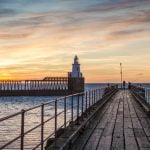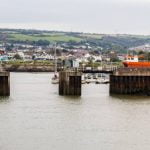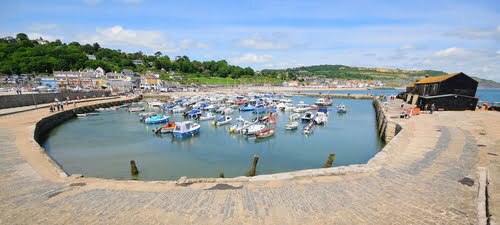
Lyme Regis in Brief
Lyme Regis is a town and seaside resort in Dorset, south-west England. It lies 25 miles (40 km) west of Dorchester and 26 miles (42 km) east of Exeter. The town sits on Lyme Bay on the English Channel at the Dorset–Devon border and the mouth of the River Lym. Dubbed the ‘Pearl of Dorset’, the town is arguably best known for its idyllic location on the Jurassic Coast and its ancient harbour, ‘the Cobb’. However, it’s also known for being a favoured shooting location for TV and film period dramas. In 2019, Lyme Regis’s population was estimated at 4,805.
A Fleeting History
Early Times
The Iron Age forts of Pilsdon Pen, Lambert’s Castle, Blackberry Castle, and Coney Castle are testament to the Lyme Regis area’s early settlement. An ancient villa found at the nearby village of Harcombe gives proof of the area’s Roman occupation. The Romans named the area “Lym Supra Mare”, where Lym was the name of the local river. The ‘Supra Mare’ part translates from Latin as ‘beyond the sea’.
In the late 8th century, the Saxon King of Wessex ‘Cynewulf’ gifted land along the River Lym to Sherborne Abbey. It gave the monks the unique right to extract salt from the mouth of the Lym. By the time of the Domesday Book of 1086, the area was known as ‘Lyme’. Around 1100, the Normans built a parish church at Lym dedicated to the Archangel Michael.
The 13th century saw Lyme develop to become one of England’s most important ports. King Edward, I sheltered his fleet in the town’s natural harbour ‘the Cobb’ during the Anglo-French wars. In 1284, as a reward, he granted a royal charter to Lyme, which saw “Regis” (meaning ‘of the King’) added to the town’s name.
Rebellion
By the 16th century, Lyme Regis had gained a reputation for its royal dissenters. Mary Tudor called Lyme ‘‘that heretic town’’ and stopped the annual grant to maintain the Cobb. When the English Civil War started in 1642, the town came out as staunchly Parliamentarian, to no one’s great surprise. In 1644, Prince Maurice, nephew of King Charles I, laid siege to the town. However, after five weeks, his royalist forces had suffered heavy losses and were forced into withdrawal.
In 1685, James, Duke of Monmouth, the illegitimate son of Charles II, sailed from Holland to Lyme Regis. His purpose was to claim the English throne from his uncle, the Catholic monarch James II. He chose to land at Lyme Regis because of its strong Protestant sympathies. Landing in June 1685, he quickly assembled an army of 3,000 local volunteers. They quickly began their march towards London. However, on 6th July, they were engaged by the King’s army near Bridgwater at the Battle of Sedgemoor. Monmouth’s army was thoroughly routed though he managed to escape the battlefield. However, he was quickly captured and taken to London. He was executed only 9 days later.
The infamous Judge Jeffreys was sent to Winchester to oversee the trials of some 1400 prisoners. The proceedings became known as the Bloody Assizes. They saw some 300 of the accused sentenced to death, while most of the rest were given transportation orders. In all, ninety-nine men from Lyme were arrested, twelve of whom were executed.
Fossils and the Famed
By the mid-18th century, Lyme Regis had become a favourite haunt of the well-heeled. It became particularly popular with the bohemian fraternity. Famous visitors included authors Henry Fielding and Jane Austin and painters William Turner and James Whistler. Some of the famed literary visitors who followed in their footsteps, include Lord Tennyson, Oscar Wilde, Beatrix Potter, GK Chesterton, PG Wodehouse, and JJR Tolkien.
In 1799, one of Lyme’s most famous residents, Mary Anning, was born. From age 12 until her death in 1849, Mary spent much of her time searching the local coastline for fossils. A pioneering amateur geologist and paleontologist, she was responsible for some of the most important fossil find in Dorset. However, she would often sell these to avid collectors to supplement her meager carpenter’s income. Sadly, Mary died before her work achieved any kind of recognition.
Triumph and Disaster
In August 1903, a branch line opened from the main rail network at Axminster to Lyme Regis. The 5-mile line of steep grades and sharp curves ran through some of England’s most picturesque countryside. The line opened with great success, which saw a big boost to Lyme’s tourist numbers.
On New Year’s Day, 1915, the battleship HMS Formidable was torpedoed off the coast of Lyme Regis. It was the first major strike by a German U-boat of World War I. The incident saw 547 of the 694 ship’s crew perish. The local lifeboat was utilised to deliver some of the bodies to the Pilot Boat Inn in Bridge Street.
In 1965, Lyme Regis’ railway station closed following the Beeching Report recommendations. The station was dismantled and rebuilt at Alresford on the Mid-Hants Watercress Line in Hampshire.
The Modern Era
Lyme Regis’ economy is largely dependant on the service sector, where tourism is a large slice of the pie. Like many resort towns, Lyme also has a large independent retail sector consisting of many bespoke shops. To promote the tourism and retail sector the town runs a large programme of annual events and festivals. This schedule consists of at least a dozen events that last between 1 – 7 days. It starts at Easter with a 2-day beer festival and ends with the Christmas lights turn-on in late November. Three of the more notable events are:
The Coast to Coast Motorcycle Run
In June, the town hosts the start of the annual Coast to Coast Motorcycle Run. The event can see more than 200 vintage and classic motorbikes gathered in the town. The rally leaves from the Cobb car park in Lyme Regis, and heads the 45 miles north to Burnham-on-Sea, on the north Somerset coast.
Lyme Regis Jazz festival
The internationally renowned Lyme Regis Jazz Festival is held during the first weekend in July. The event includes a display by the famed RAF’s air display team the Red Arrows
Regatta & Carnival Week
The Regatta and Carnival usually takes place in early August. It opens with the Sailing Club Regatta Race. The week culminates with a grand parade and firework display.
Other annual events include:
- The Easter Bonnet Parade
- Lyme Regis Fossil Festival – early May
- Lyme Regis Masters Gig Regatta – early June
- Uplyme and Lyme Regis Horticultural Society Show – mid-July
- Morris Dancing Day – mid-July
- Lifeboat Week – late July
- Lyme Splash Water Polo Sea Championship – late August.
- Lyme Regis Folk Weekend – late August
- Food Rocks – two days in early September
- Fireworks And Bonfire On The Beach – early November
Lyme is twinned with the town of St. Georges in Bermuda. Why Bermuda you might ask? See ‘A Notable Son’ below.
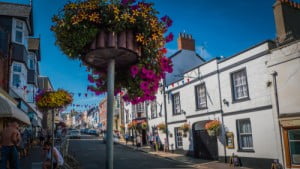
Lyme hosts lots of annual events. Image Credit: Vivvi Smak /Shutterstock.com
Getting to Lyme Regis
Road
Driving to Lyme is probably the easiest travel option. For the 150 mile journey from London, take the M3, M27, A31, and A35. It’s a short journey from the A35 at the Old Stables to Lyme.
Train
The nearest train station to Lyme is Axminster, about 6 miles away. There are direct trains from London Waterloo to Axminster from where you can take a bus. Trains run hourly from Waterloo, with the 150-mile journey taking around 2 hours 40 minutes. From the Midlands and North, you’ll need to change trains. For most, this will probably be at Bristol.
Bus
Travelling by bus is cheaper than the train, but the journey will take 5-7 hours from London. Buses depart both Hammersmith Bus Station and Victoria Coach Station. Services to Lyme are operated by National Express and Go Euro (Omio).
Air
If you want to fly to Lyme Regis, the nearest airports are Exeter (28 miles) and Bristol (60 miles). You’ll obviously need to take a train or bus to arrive at Lyme Regis.
Did you know?
Lyme Regis born 19th-century paleontologist Mary Anning is thought to have been the inspiration behind the UK’s best-known tongue twister. I’m pretty sure you already know it? Yes, of course, it’s ”She sells seashells on the seashore”.
A Notable Son
Lyme’s former mayor and MP, Admiral Sir George Somers was born in the area in 1554. In 1609, the esteemed royal navy officer and privateer found himself shipwrecked on a Caribbean island on his way to Jamestown, Virginia. While there, he founded the English colony of the Somers Isles, now Bermuda. Somers died in Bermuda on 9 November 1610, aged 56. Local legend has it that he requested his heart be buried on the islands. The location of the supposed burial is at Somers’ Gardens in St George’s, where the spot is appropriately marked. The remainder of his body was returned to Whitchurch Canonicorum, the small hamlet, near Lyme, where he was born.
Things to do!
Hit the Beach!
If you’re looking for beach time, Lyme has four of them. Town Beach, not too unsurprisingly, is the closest to the town and has the most amenities. Lifeguards man the beach during the summer months. You’ll also find kiosks, takeaways, cafes, restaurants, and public houses, etc., lining the beach. Monmouth beach is where the Duke of Monmouth famously landed from France in 1685. Today at the beach, you’ll find holiday chalets, beach huts, a bowling green, Lyme Regis Power Boat Club, and the Boat Building Academy. There’s also plenty of parking!
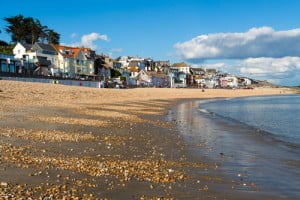
Town Beach. Image credit: Ian Woolcock/Shutterstock.com
The least popular beaches are East Cliff Beach and Church Cliff Beach. They have no amenities but make a good destination for a morning stroll. Church Cliff, a mix of sand and shingle, is at the mouth of the Lym. Low tide exposes a host of rock pools, so good for kids to explore. East Cliff is mainly shingle with mudflats with nearby cliffs that are prone to collapse. You should be able to find a fossil or two!
Boating and Fishing
Boat trips and fishing are popular things to do off the Lyme coast. Most of the local maritime companies operate out of the local harbour. Trips options include those by the adrenaline-packing RIBs (rigid inflatable boats) or the much more relaxed leisure cruises. If you fancy a go at sea angling, there’s a choice between mackerel fishing and deep-sea fishing. Mackerel fishing tends to be more popular with families. Fishing trips durations can be organised for as little as 3 hours.
Biking and Hiking
There’s plenty of opportunities for hiking and biking around the Lyme area. As you might expect, given the town’s idyllic location, the area is considered somewhat of a walker’s paradise. There are loads of recognised short walks, including a historic sightseeing walk around Medieval Lyme itself. Walks to nearby Charmouth, Rousden, and Axmouth, amongst others, are popular. For long-distance walkers, the South West Coastal Path passes through Lyme. Similarly, there are loads of local cycling routes.
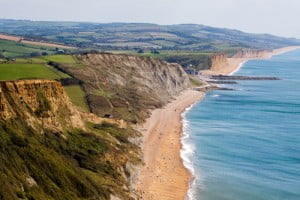
The ‘Jurassic Coast’ – popular with walkers. Image credit: Martin Kemp/Shutterstock.com
Places to see!
Any Fossil Hunters?
If you’re interested in fossils then a visit to Lyme Regis Museum is a must. It houses one of the country’s best fossil collections. There’s also an exhibition telling the life story of Mary Anning. Why is it there are so many fossils on Dorset’s Jurassic coast? Visit the museum and find out! You can also walk in Mary’s footsteps as the museum organises special fossil walks.
Just can’t get enough of fossils? Then, you can also look up the Dinosaurland Fossil Museum. It also houses another of the country’s best displays. It has more than 12,000 specimens on permanent display. The spectacular collection includes Jurassic marine fossils up to 200-million-years-old. If that’s not enough to get you going, there’s also a huge fossilised lump of dinosaur poo.
Popular Places
The award-winning Town Mill is one of Lyme Regis’ leading attractions. It houses a working watermill that produces flour in much the same way it has for most of the last 500 years. The mill’s outbuildings also house several art galleries, some handicraft businesses, a cafe, and a micro-brewery. There’s also a Medieval cobbled courtyard and a landscaped ‘miller’s garden’.
Lyme Regis Marine Aquarium displays local sealife and tells the town’s maritime history. Visitors have the opportunity to get hands-on with the likes of starfish and lobsters. The shoal of tame grey mullet tends to be a big favourite. The aquarium is located at the Cobb.
Another popular place to visit near Lyme is the former Cistercian monastery Forde Abbey. The 900-year-old house is situated on a 1,600-acre estate. The stunning gardens were set out in the 18th and 19th centuries. The ‘Great Pool’ is the sole surviving feature from the house’s time as a monastery. The Abbey itself runs a programme of events throughout the year.
Where to Stay?
Lyme Regis and the surrounding area offer a variety of accommodation choices that should suit all tastes and budgets. If you are looking for a budget stay, then there are hostels and caravans. At the top end, there are luxury country houses. You should also be able to find just about every other accommodation choice between. These include hotels, guesthouses, B & B’s, Inns, self-catering cottages, and apartments.
Thinking of moving to Lyme Regis?
Over the last year (Aug 2021), properties in Lyme Regis had an average selling price of £430,300. The majority of those sales were detached properties, which sold for an average price of £610,000. Semi-detached property sales averaged £382,000, while flats fetched approximately £248,000. Lyme Regis property prices over the last year saw a 10% rise on the previous year.
Planning a Staycation?
Are you thinking of holidaying in the UK sometime soon? If so, why not check out some of our other travel guides for some staycation ideas. I think you’ll be surprised at the variety of great things to do in the UK’s fairly green and mostly pleasant land.
Header image credit: Savo Ilic/Shutterstock.com
